Spacetime ripples from neutron star smash-up usher in age of multi-messenger astronomy.
So the rumors were right after all. On August 17th, the Advanced Laser Interferometer Gravitational-Wave Observatory (LIGO) registered tiny ripples in spacetime, produced by a pair of frantically orbiting neutron stars right before they collided. What’s more: telescopes on the ground and in space detected the fading glow of the radioactive fireball that resulted from the cosmic smash-up, all across the electromagnetic spectrum.
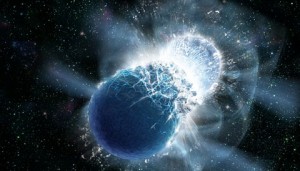
Dana Berry / SkyWorks Digital, Inc.
"The detection of gravitational waves from a binary neutron star merger is something that we have spent decades preparing for," notes astrophysicist Alan Weinstein (Caltech). "All of our dreams came true." According to his colleague Barry Barish (also Caltech), one of LIGO’s founding fathers and co-recipient of the 2017 Nobel Prize in Physics, the new discovery "establishes gravitational-wave science as a new emerging field." Vicky Kalogera (Northwestern University) adds, "I couldn’t believe my eyes. It’s a lot more exciting than the first gravitational-wave detection" of colliding black holes, in September 2015.
The excitement is fully justified. Observing both gravitational waves and electromagnetic radiation from the catastrophic coalescence of two hyper-dense neutron stars provides astronomers with a wealth of new, detailed information. The new buzzword is multi-messenger astronomy, the study of the universe using fundamentally different types of emission.
Rumors about the neutron star event have circulated since August 18th, when Craig Wheeler (University of Texas at Austin) tweeted: "New LIGO. Source with optical counterpart. Blow your sox off!" Then, on September 27th, the LIGO-Virgo Collaboration announced the detection of GW170814 — the gravitational wave signal of a black hole merger — leading some to assume that the earlier rumors had been just hype.
However, because colliding black holes don’t give off any light, you wouldn’t expect any optical counterpart. In a speech October 3rd after his co-reception of the physics Nobel, Ranier Weiss (MIT) confirmed another announcement was coming but wouldn’t say what. Today, at a large press conference in Washington, D.C., astronomers and physicists finally revealed their secret.
Colliding Neutron Stars
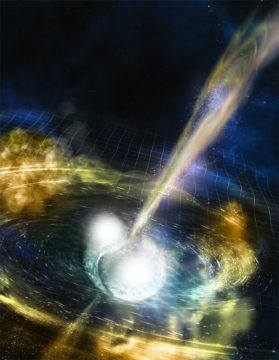
NSF / LIGO / Sonoma State University / A. Simonnet
Here’s what happened. On Thursday, August 17th, at 12:41:04 UT, LIGO bagged its fifth confirmed gravitational-wave signal, now designated GW170817. But this signal lasted much longer than the first four: instead of a fraction of a second, like the earlier detections, the spacetime ripples lasted for a whopping ninety seconds, increasing in frequency from a few tens of hertz to about one kilohertz — the maximum frequency that LIGO can observe.
This is the gravitational-wave signal expected from closely orbiting neutron stars, both less than two times the mass of the Sun. Eventually they whirled around each other hundreds of times per second (faster than your kitchen blender), at a fair fraction of the speed of light. The waves emitted by the accelerating masses kept draining the system of orbital energy, and before long, the two neutron stars collided. The collision took place at a distance of roughly 150 million light-years from Earth.
Astronomers have known about binary neutron stars since 1974, when Russell Hulse and Joseph Taylor discovered the first one, with a separation of a few million kilometers and an orbital period of 7.75 hours. But that separation and period are changing with time. In fact, the binary’s very slow decrease in orbital period, measured over subsequent years, perfectly matches Einstein’s prediction for energy loss due to the emission of gravitational waves. Some 300 million years from now, the two neutron stars in the Hulse-Taylor binary will also collide and merge.
The discovery of the first binary neutron star, which earned Hulse and Taylor the 1993 Nobel Prize in Physics, provided a huge boost of confidence for physicists such as Weiss and Kip Thorne (Caltech), who were designing the first prototypes of LIGO-like laser interferometers and who shared the 2017 Nobel with Barish. If one binary neutron star would coalesce in 300 million years, others might do so tomorrow. The energetic burst of gravitational waves produced by the collision should be detectable with extremely sensitive instruments here on Earth. Talking about GW170817, Ralph Wijers (University of Amsterdam, The Netherlands) says, "We’ve been waiting for this for 40 years."
The Gamma-ray Burst
Just two seconds after the gravitational-wave event, at 12:41:06 UT, NASA’s Fermi Gamma-ray Space Telescope detected a short gamma-ray burst — a brief, powerful “flash” of the most energetic electromagnetic radiation in nature. The European Space Agency’s Integral gamma-ray observatory confirmed the outburst.
Short gamma-ray bursts are thought to be produced by colliding neutron stars. The merger would blast two narrow, energetic jets of particles and radiation into space (probably perpendicular to the neutron stars’ orbital plane). If one of the jets were directed toward Earth, we would see a gamma-ray burst lasting anywhere between a fraction of a second and two seconds or so. The natural question was, could GRB170817A possibly be related to the LIGO event that was observed just before?
Astronomers had doubts. Gamma-ray bursts usually occur at distances of billions of light-years. GRB170817A looked about as bright to Fermi as other GRBs, so if this burst had occurred at a mere 150 million light-years distance, it must have been unusually wimpy. Moreover, it would be an uncanny coincidence that the nearest gamma-ray burst ever would have its jet pointed toward Earth.
Virgo to the Rescue
Finding an optical counterpart to either the gravitational “Einstein waves” or to the short gamma-ray burst would settle the issue. Unfortunately, astronomers couldn’t precisely pinpoint the source of the signals on the sky. Fermi’s ”error box” measured a few tens of degrees in diameter (the full Moon is only half a degree wide), and NASA’s Swift satellite, which sometimes can catch a Fermi event with its more precise X-ray telescope, didn’t see any X-ray emission immediately after the GRB.
As for the gravitational-wave signal, the situation looked even worse. The event had been observed by both the LIGO detector in Hanford, Washington, and its twin in Livingston, Louisiana (although it took a while before the Livingston signal was retrieved from the data stream because of a technical glitch). From the tiny difference in arrival time (just a few milliseconds), it was possible to trace the origin of the gravitational waves back to a long, thin banana-shaped strip of sky. But although the banana was extremely thin in this particular case (thanks to the long duration of the event), it was also very long.
The thin LIGO banana did cross the Fermi error box, in the constellations Virgo and Hydra. Alas, the overlap region was still much too large to start a focused search for a possible optical counterpart of the event, which would probably be extremely faint.
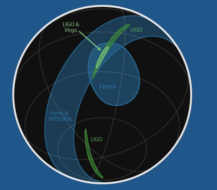
LIGO / Virgo
But wait a minute — what about the third gravitational-wave detector, in Italy? Virgo had been up and running in tandem with LIGO since August 1st. Differences in arrival time for three detectors make it possible to triangulate the source location much more precisely. In fact, that was exactly what had happened three days before, with the black hole merger GW170814. So wouldn’t the Virgo observations of GW170817 provide an answer?
Almost two months after the events, Vicky Kalogera is still high on adrenalin when she explains the role of the European Virgo detector in solving the case. “In August,” she says, ”I was vacationing with my family in Colorado and Idaho, where we would observe the August 21st total solar eclipse. I had promised not to be working all the time. Then came GW170814, and three days later the neutron star event. I’ve been at my laptop and in telecons ever since.”
Surprisingly, she recounts, Virgo did not "trigger" on GW170817. The 90-second Einstein wave signal of the coalescing neutron stars almost doesn’t show up in Virgo’s data stream, even though the European instrument shouldn't have had any problem detecting it. “The great thing,” says Kalogera, ”is that Virgo’s 'non-detection' turned out to be the key to localizing the source.”
Laser interferometers like LIGO and Virgo can detect gravitational waves from nearly every direction. But because of their design, there are four regions of sky on the instrument’s local horizon for which the detection sensitivity is much lower than average. At the very center of those regions are blind spots. Virgo had't registered a strong, passing gravitational wave because the source of the waves was located near one of Virgo’s blind spots.
Lo and behold, this spot coincided with the overlap region between LIGO’s thin “banana” and Fermi’s error box. Given the upper limits on the Virgo signal, astronomers were able to fence off a much smaller, elongated part of the sky, with an area of just some 28 square degrees.
Counterpart search
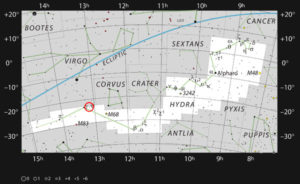
ESO / IAU / Sky & Telescope
Now the hunt was on. Over the past years, the LIGO-Virgo Collaboration had signed a formal agreement with some 70 teams of astronomers all over the world to share this kind of information under strict embargo. This would enable the teams to search for electromagnetic counterparts of any gravitational-wave signals with telescopes on the ground and in space, preferably right after the detection. With the latest coordinates of the search area for GW170817 in hand, everyone trained their instruments at the suspected crime scene in southern Virgo and eastern Hydra.
The 1-meter Henrietta Swope Telescope at the Las Campanas Observatory in northern Chile was the first to strike gold. Their success depended on a clever strategy. The LIGO data provided them with an indication of the source’s distance, and within the search area there were only a few dozen galaxies at this distance range. Astronomers with the Swope Supernova Survey rapidly checked the galaxies one by one, in order of probability, to see if they could find an optical transient.
Around 23:00 UT, they found a surprisingly bright (17th magnitude) point of light at the northeastern edge of the lenticular (S0) galaxy NGC 4993, near the binary star Gamma Hydrae. The source was bright enough for amateur astronomers to have picked out with large (16-inch) telescopes. The galaxy’s redshift puts it at a distance of 130 million light-years. Without doubt, here was the optical counterpart of both the neutron star collision that produced the gravitational-wave signal and the short gamma-ray burst — smack in the overlap region of LIGO’s banana, Fermi’s error box, and Virgo’s blind spot.
In the subsequent days and weeks, dozens of ground-based telescopes and space observatories observed that point, including the Hubble Space Telescope, the Gemini South, Keck, the European Southern Observatory’s Very Large Telescope, ALMA, the Chandra X-ray Observatory (it picked up X-rays some 9 days after the event), and the Very Large Array (16 days after the crash).
”I would think this is the most intensely observed astronomical event in history,” Kalogera says. The paper describing the follow-up observations (unofficially known as the “multi-messenger paper”) is coauthored by almost 4,000 astronomers from more than 900 institutions. “This represents about one-third of the worldwide astronomical community,” she says. And it’s only one of many papers on GW170817 that will go online today (October 16th), in journals including Physical Review Letters, The Astrophysical Journal, Science, and Nature.
Striking gold
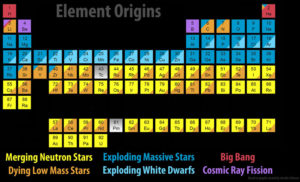
Jennifer Johnson / SDSS / CC BY 2.0 (modified)
The fading aftermath of the neutron star collision has now been observed at every possible wavelength, from X-rays and ultraviolet through optical and infrared, all the way to millimeter and radio waves. The aftermath phenomenon is known as a kilonova — an explosive event less luminous than a supernova, but about a thousand times as bright as a normal nova. Only once before, in June 2013, have astronomers found a kilonova in conjunction with a short gamma-ray burst, but that one was extremely faint, occurring at a distance of some 4 billion light-years.
The kilonova is basically the sizzling fireball from the neutron star smash-up. Chunks of hot, dense nuclear matter are hurled into space, in all possible directions, with velocities easily reaching 20% or 30% the speed of light. Liberated from the neutron stars’ extreme gravity, the debris expands, rapidly losing its ultra-high density. Neutrons now start to decay into protons, and in the resulting thermonuclear cauldron, these two types of particles combine into heavy atomic nuclei, many of which are highly radioactive. What remains is an incredibly hot expanding shell, loaded with some of the heaviest elements in the periodic table.
Spectroscopic observations by the X-Shooter instrument at the Very Large Telescope and other instruments have indeed revealed the existence of so-called rare earth elements and other heavy metals like platinum, lead, and gold. The observations appear to confirm the theory that the majority of elements more massive than iron are produced by the decay of nuclear matter in the aftermath of neutron star collisions, rather than in supernova explosions.
Apparently, with the discovery of the counterpart of GW170817, scientists also literally struck gold. Edo Berger (Harvard-Smithsonian Center for Astrophysics) once calculated that a run-of-the-mill neutron star merger may produce no less than 10 times the mass of the Moon in pure gold. Gijs Nelemans (Radboud University, The Netherlands) thinks it may well be much higher, up to a few Earth masses.
According to Edward van den Heuvel (University of Amsterdam), a retired expert on compact binary star evolution, 16 binary neutron stars have so far been discovered in the Milky Way. “From this number, I estimate that neutron star collisions occur once every 50,000 years or so in our Milky Way galaxy,” he says. ”Over the age of the Milky Way, that amounts to a few hundred thousand of these gold-spawning events in just one galaxy. That’s a lot of gold.”
Remaining mysteries
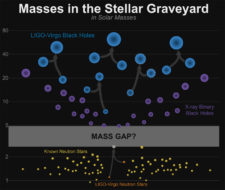
LIGO / Virgo, Frank Elavsky / Northwestern
A few mysteries remain, though. One is the nature of the gamma-ray signal observed by Fermi. If GRB170817A was a regular gamma-ray burst, one of its jets must have been aimed at our home planet. But in that case, astronomers would have expected to detect a gamma-ray brightness at least 10,000 times more powerful than what they did, given the small distance of 130 million light-years.
However, the jets should also have produced prompt X-ray emission, which was not detected. Even if we happened to observe the jet at an angle of, say, 20 degrees (which might explain the low gamma luminosity), X-rays would have been expected, too.
Kalogera, Eleonora Troja (NASA Goddard and University of Maryland), who led the X-ray follow-up, and others still think that an off-axis jet is the most likely explanation for the weakness of the gamma-ray burst. Troja also says that the delay in X-rays would be natural when looking at the jet from an angle.
Mansi Kasliwal (Caltech) suggests a different scenario, in which the jets get stuck in a thick cocoon of material that was ejected by the neutron star collision. In her model, when the cocoon becomes less dense, it may briefly emit isotropic gamma-rays itself, at a much weaker level. Wijers had put forward a similar scenario to explain the strange behavior of the burst GRB980425, which was also relatively close and surprisingly weak, and coincided with a supernova-like explosion known as SN 1998bw. Wijers also notes that the model neatly accounts for the transition of the optical counterpart of GRB170817 from blue to red wavelengths within 48 hours.
A detailed analysis of kilonova observations may eventually solve the issue. And future observations of the site of the cosmic catastrophe could also shed light on another as-yet-unsolved mystery: what was the fate of the two neutron stars? Sure, a small fraction of their combined mass was ejected into space, but what happened to the rest? Did the two city-sized stars merge into a hyper-massive neutron star of a few solar masses, or did they collapse into a stellar-mass black hole? Astronomers have only detected a couple of neutron stars that weigh in above 2 solar masses — an upper limit that might have implications for the physics of these stars. The merger remnant’s mass could potentially be extremely informative.
The LIGO data can’t provide the answer; the final stages of the merger event weren’t observed. With the earlier black hole collisions, LIGO could detect hints of the collision’s “ring-down phase,” a brief period in which the amplitude of the Einstein waves rapidly dwindled down to zero. From the characteristics of this ring-down, astronomers were able to estimate the final mass of the merged black hole.
But in the case of GW170817, the wave frequency had become too high for LIGO to observe it before the two neutron stars actually collided, and it lost the signal, says Kalogera. So astronomers do not have any observational data to constrain the properties of the merged objects. Moreover, estimates of the neutron stars’ initial masses are not precise enough to provide much help.
Nelemans is confident enough to claim that the collision must have produced a new black hole. “If there was a neutron star there right now, it would be extremely hot, and we would have detected it in X-rays,” he says.
But Kalogera is not so sure. ”We really have no idea,” she says. ”The X-ray signal from the hot surface may temporarily be absorbed by the ejecta. I wouldn’t exclude the possibility of a hyper-massive neutron star. Who knows, within a few weeks or months, we may be lucky enough to detect radiation from its surface, or maybe even pulses [of X-rays or radio waves], due to the object’s extremely rapid rotation.”
Making History
To sum up, the observations presented today, spectacular as they already are, may turn out to be the proverbial tip of the iceberg of future revelations on gamma-ray bursts, binary star evolution, heavy element synthesis, general relativity, the behavior of matter in extreme environments, and the properties of neutron stars. Physicists are particularly interested in the material properties of these hyper-dense stellar remnants, which easily pack a hundred thousand tons of matter into a volume of one cubic millimeter. We can’t possibly hope to recreate such extreme conditions in a laboratory on Earth.
In principle, a detailed study of gravitational-wave signals such as GW170817 should provide more information. As the two neutron stars draw closer and closer, they will be stretched and squeezed by mutual tidal forces. The magnitude of the resulting deformations tells physicists something about the interior structure of the star, the way its density changes with depth, its material stiffness, et cetera. This so-called equation of state has not yet been determined on the basis of the current GW170817 observations. In all likelihood, it will take many more similar events before it becomes possible to draw the right statistical conclusions.
Still, explains Kalogera, the fact that the neutron star coalescence produced a massive, relativistically expanding fireball (the kilonova) puts some constraints on the equation of state. “For a variety of reasons, the new observations are more easily explained if neutron stars are on the small side of the postulated size range,” she says — probably more like 20 kilometers across than 30. Smaller sizes could indicate extreme forms of matter deep within the neutron stars’ cores (see S&T’s July 2017 cover story for details).
So yes, Nobel laureate Barry Barish is absolutely right: the new discovery establishes gravitational-wave science as a new emerging field. And it’s emerging fast, too. Van den Heuvel can’t wait to see the next spectacular breakthrough. “These measurements are incredibly hard,” he says. “Measuring spacetime ripples that are much smaller than an atomic nucleus is almost impossible to imagine. But within 20 years or so, gravitational-wave measurements may be just as routine as X-ray observations have become over the past 40 years. It’s really beyond my wildest dreams.”
Read the behind-the-scenes story of the first gravitational-wave detection from merging black holes in our September 2017 issue.
 13
13









Comments
Anthony Barreiro
October 16, 2017 at 3:02 pm
This is an amazingly thorough and deep report on such a recent announcement! Thank you, Mr. Schilling.
I'm especially curious to know what remains after a binary neutron star merger. What sort of instrument would be needed to detect higher-frequency gravitational waves? Would a very long interferometer in space, like LISA, do the trick?
These are glorious days in astrophysics!
You must be logged in to post a comment.
Ron
October 23, 2017 at 1:17 pm
Agree! Great article.
You must be logged in to post a comment.
Graham-Wolf
October 17, 2017 at 12:56 am
Awesome news!
The LIGO team must be rubbing their hands with glee.
Heard about it late last night on my national Radiolive News, here in NZ.
This morning, got to hear a Cardiff Professor explain in more simple detail.
The density of a neutron star equates to compressing the entire mass of the Sun into a sphere just 10km across!
Graham W. Wolf at 46 South, Dunedin, NZ.
You must be logged in to post a comment.
tom-dasilva
October 17, 2017 at 1:30 pm
Great article leads to some questions...wouldn't the neutron stars be tidally locked and in a perfectly circular orbit? It seems more like a merger without much impact.
You must be logged in to post a comment.
Martian-Bachelor
October 24, 2017 at 6:03 pm
I could be entirely wrong, but I think the neutron star material is too rigid to exhibit the kind of deformation you may be accustomed to dealing with in other, less extreme, situations. The "mountains" on a neutron star's surface are less than 1 cm in height (according to a textbook I have - I haven't calculated them). It takes an enormous amount of energy to lift anything in such an intense gravity field and keep it there.
But I'm not sure anyone knows what the initial state may be like before the Big Show, other than the fact that the orbital speeds are about a quarter the speed of light. Maybe somebody who knows more will enlighten us.
When they first make contact, the two stars grind against each other, creating by friction a hot spot which conceivably could be detected before the eventual big cataclysm -- if one knew where to look. Individual neutron stars that have been around a good while are cold by comparison, and isothermal (because of their high heat conductivity), so some of this heat energy goes into raising the stars' temperatures, causing them to expand in size slightly (by thermal expansion), hastening the process (positive feedback). The friction also consumes some of the orbital energy, which acts in the same direction.
I agree with the above consensus that this is much more significant than the HUGE discovery two years ago. Too bad they can't give several year's worth of Nobel Prize money out for a single discovery, because if it gets split among several dozen (or thousand) people it won''t work out to very many pennies per hour they've spent in preparation. Since the military industrial complex burns through at least 60,000 kilobucks per hour, Congress should pass a law and divert some tiny fraction of it for a short period of time to Team Science in recognition for this achievement. The war machine would never miss it. If only there was a tax on stupidity... lol
You must be logged in to post a comment.
xinhangshen
October 20, 2017 at 9:48 pm
No, LIGO's calculation must be wrong because it is based on Einstein's relativity while Einstein's relativity theory has already been disproved both logically and experimentally (see "Challenge to the special theory of relativity", March 1, 2016 on Physics Essays and a press release "Special Theory of Relativity Has Been Disproved Theoretically" on Eurekalert website: https://www.eurekalert.org/pub_releases/2016-03/ngpi-tst030116.php ). The problem of Einstein's relativity is that it has redefined time and space through Lorentz Transformation. The newly defined time is no longer the physical time measured with physical clocks, which can be easily demonstrated by the following thought experiment of candle clocks:
There are a series of vertically standing candles with the same burning rate and moving at different constant horizontal velocities in an inertial reference frame of (x, y, z, t) where x, y, z, t are relativistic positions and time. At any moment t of relativistic time, all candles have the same height H in the reference frame of (x, y, z, t) and the height has been calibrated to physical time as physical clocks. Therefore, we have the simultaneous events of the observation measured in both relativistic time and physical time in the frame of (x, y, z, t): (Candle1, x1, y1, H, t), (candle2, x2, y2, H, t), …, (CandleN, xN, yN, H, t). When these events are observed on anther horizontally moving inertial reference frame (x', y', z', t'), according to special relativity, these events in the reference frame of (x', y', z', t') can be obtained through Lorentz Transformation: (Candle1, x'1, y'1, H, t'1), (Candle2, x'2, y'2, H, t'2), … , (CandleN, x'N, y'N, H, t'N) where t'1, t'2, …, and t'N are relativistic times of the events in the frame of (x', y', z', t'). It is seen that these events have different relativistic times after Lorentz Transformation in the frame of (x', y', z', t'), i.e., they are no longer simultaneous measured with relativistic time in the frame of (x', y', z', t'), but the heights of the candles remain the same because the vertical heights here do not experience any Lorentz contraction. Since the heights of the candles are the measures of the physical time, we can see these events still have the same physical time, i.e., they are still simultaneous measured with the physical time. Therefore, the physical time is invariant of inertial reference frames, which is different from relativistic time. As relativistic time is no longer the physical time we measure with physical devices, the description of special relativity is irrelevant to the physical world.
Now let's have a look at the symmetric twin paradox. Two twins made separate space travels in the same velocity and acceleration relative to the earth all the time during their entire trips but in opposite directions. According to special relativity, each twin should find the other twin’s clock ticking more slowly than his own clock during the entire trip due to the relative velocity between them because acceleration did not have any effect on kinematic time dilation in special relativity. But when they came back to the earth, they found their clocks had exact the same time because of symmetry. Thus, there is a contradiction which has disproved special relativity. This thought experiment demonstrates that relativistic time is not our physical time and can never be materialized on physical clocks.
Now let's look at clocks on the GPS satellites which is thought as one of the strong evidences of Einstein's relativity. Many physicists claim that clocks on the GPS satellites are corrected according to both special relativity and general relativity. This is not true because the corrections of the atomic clocks on the GPS satellites are absolute changes of the clocks (i.e. the same observed in all reference frames), none of which is relative to a specific observer as claimed by special relativity. After all corrections, the clocks are synchronized not only relative to the ground clocks but also relative to each other, i.e., time is absolute and special relativity is wrong.
This is a fact as shown on Wikipedia. But some people still argue that the clocks on the GPS satellites are only synchronized in the earth centered inertial reference frame, and are not synchronized in the reference frames of the GPS satellites. If it were true, then the time difference between a clock on a GPS satellite and a clock on the ground observed in the satellite reference frame would monotonically grow due to their relative velocity while the same clocks observed on the earth centered reference frame were still synchronized. If you corrected the clock on the satellite when the difference became significant, the correction would break the synchronization of the clocks observed in the earth centered frame. That is, there is no way to make such a correction without breaking the synchronization of the clocks observed in the earth centered frame. Therefore, it is wrong to think that the clocks are not synchronized in the satellite frame.
Hefele-Keating experiment is also considered as another evidence of relativistic effects. It is clear that all the differences of the clocks after flights in Hefele-Keating experiment were absolute (i.e., they were the same no matter whether you observe them on the earth, on the moon or on the space station). But according to relativity, if the clocks were observed on the earth, the two clocks after flights had experienced the equivalent paths of same velocity and same distance in same elevation, and thus should generate the same kinematic time dilation and the same gravitational time dilation, directly contradicting the experimental result. Therefore, the differences of the clocks were nothing to do with the velocities relative to each other or relative to the earth as claimed by relativists, but were the result of the velocities relative to one medium which seems fully dragged by the earth on its surface but partially dragged on the altitude of the airplanes. It is wrong to interpret the differences of the displayed times of the clocks as the results of relativistic effects.
Experiments show that electrons will emit photons when they are "moving", but “moving” is relative. All electrons on the earth can be considered "moving" when you observe them on a rocket. According to special relativity, you should see them emit photons. Why in a rocket frame don't you see the electrons emit photons? It is because special relativity is wrong. It is not the velocity relative to the observer which makes an electron emit photons, but it is the velocity relative to “something” makes an electron emit photons. This “something” is aether, the existence of which has been proved in the above paper. Photons are waves of aether which is a compressible viscous fluid filling up the entire visible part of the universe, though its viscosity is very very small. It is the velocity relative to aether makes an electron emit photons, just as a boat on a water generates waves only when it moves relative to the water.
The increase of the lives of muons in particle accelerators or going through the atmosphere are the effects of aether caused by their velocities relative to aether, which are absolute changes and the same observed in all reference frames, nothing to do with relativity.
All so-called proofs of relativistic effects are just misinterpretations of experiments and observations without exception, and all what relativity describes is irrelevant to physical phenomena, including the speed of light which in special relativity is constant in all inertial reference frames, but which in real physical world still follows Newton's velocity addition formula (see the paper).
That is, time is absolute and space is 3D Euclidean. There is nothing called spacetime continuum in nature, not to mention the ripples of spacetime.
You must be logged in to post a comment.
Stub Mandrel
October 21, 2017 at 10:55 am
If you say so...
You must be logged in to post a comment.
Martian-Bachelor
October 24, 2017 at 5:29 pm
This is straight out of The Space Child's Mother Goose (Winsor and Parry), "This is the Theory that Jack Built":
This is the theory that Jack built.
This is the flaw that lay in the theory that Jack built.
This is the mummery hiding the flaw that lay in the theory that Jack built.
This is the flummery disguising the mummery hiding the flaw that lay in the theory that Jack built, etc...
LOL
You must be logged in to post a comment.
October 21, 2017 at 10:31 am
It's a bit disappointing that they 'embargoed' these data from the prying eyes of the amateur community. A lot of us would have liked to get a look at the historic 17th mag outburst; heck, some of the more equipped could have even assisted in finding it!
You must be logged in to post a comment.
JWRIGHT1127
October 24, 2017 at 3:29 pm
Quite a while back I had some experience with chirped pulse compression radar, which does a good job of digging weak reflected signals out of the receiver noise. See the following for a description of the method: https://en.wikipedia.org/wiki/Pulse_compression. I'm wondering, is that's part of the inner workings of LIGO? The accelerating collapse of a binary neutron star system creates GWs with an upward frequency shift (i.e., chirp), and the electric waveform coming from the interferometer is of like kind, thought it might be overwhelmed by noise. A diode-type detector would not work on such an obscured signal, but coherent detection will. Its exact properties (FM range, rate of frequency increase, etc.) are not known beforehand, but it is only an audio range signal. "Pseudocoherent" detection should be possible using computer iteration with trial chirp functions and saved time domain data, especially on data that precede a gamma ray burst trigger by a few seconds. This entire area of physics is fascinating.
You must be logged in to post a comment.
LLG
October 26, 2017 at 9:46 am
As an eighth grade student, I find this fascinating, it's an event that I didn't even know happened! I've always been interested in space, and this article just sprung my curiosity even more. It's a whole new way of looking at the universe, a whole new perspective. I've even decided to tell my Earth and Space Science class about this, I think my teacher will love it.
You must be logged in to post a comment.
Harry Powell
October 26, 2017 at 12:51 pm
It isn't science, but the late Robert L Forward's novel "Dragon's Egg" (published 1980) is a good read. It is about a trip to a neutron star in the constellation of Draco, at RA 11:31:46 Dec +69deg 18' 01" (1 lambda Draconis). The book has a technical appendix that is quite interesting! The neutron star in the story will be discovered in 2020.
You must be logged in to post a comment.
Esnuka
October 29, 2017 at 4:41 pm
The detection of the gravitational waves produced by the merger of two neutron stars –GW170817– has allowed scientists to fix at 70 km/s per megaparsec * the value of the increase in speed of the expansion of the universe in the 130 million light years that separate us from the origin of said merger.
As these calculations approach the speed of light throughout the age of the universe, we can do the inverse calculation to determine the average increase in the velocity of expansion so that the observable universe is of the age stated by the Big Bang Theory.
The result is 300.000 km/s /(13.799/3,26) Mpc =70,820 km/s Mpc. https://molwick.com/en/gravitation/072-gravitational-waves.html#big-bang
You must be logged in to post a comment.
You must be logged in to post a comment.